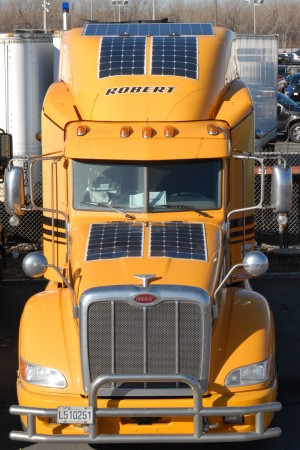A bright idea from Groupe Robert
BOUCHERVILLE, Que. — Keen eyes have noticed that many of Quebec-based Groupe Robert’s liquid natural gas (LNG) trucks have solar panels mounted atop their hoods and cab deflectors. They are charging batteries that deliver power to the cab’s air conditioning (AC) and electrical devices when the rigs are parked and the engines turned off. It is a simple, yet remarkably successful home-cooked idea. The 300-watt, four-battery system that Robert has devised provides enough electricity to last from dusk to dawn, and eliminates the need for an on-board diesel-powered generator.

The LNG fleet is being retrofitted with the system, so the return on investment is earned by not having to run the trucks’ diesel generators anymore. For new trucks destined for long-haul work, however, Robert is using the money not spent on Thermo King TriPacs to purchase the solar hardware and have its dealers install the systems. (Robert is investigating the possibility of using a Webasto electrical heater to replace the Webasto direct-fire cab heaters).
Since the outlay for a solar system – about $14,000– is the same as for the diesel-powered system that trucks would otherwise require, Robert is not out of pocket any extra money for new tractor orders. Robert goes into the black on the first overnight trip, to the tune of the cost of a litre of diesel saved every hour the solar system runs the in-cab equipment. This is a rare and enviable affair for a fuel-saving technology.
The solar project began in 2013 when Robert bought a 2×4-foot, 100-W rigid solar panel, originally developed for recreational vehicles. Robert’s dealer in St-Julie, Excellence Peterbilt, cut a hole in the cab deflector and installed the solar panel. Excellence also installed a controller to prevent overcharging of four deep discharge batteries mounted behind the cab in a steel box; these batteries are used only to power the in-cab equipment. The system, which includes a Bergstrom NITE Phoenix AC system, is completely separate from the rest of the tractor’s electrical system.
Since AC is stock equipment on all tractors, they run when the tractors are running. The NITE Phoenix units take over when the engines are shut off. The 100-W system was not quite enough, Robert learned.
“It gave us five to six hours of autonomy, with AC, in very warm weather in the southern US in the summer,” says Yves Maurais, technical director, asset management, purchasing and conformity, Groupe Robert.
After learning about the availability of 50-W flexible panels, about 1×2-ft apiece, Robert added four – two on the hood and two up on the cab deflector, to boost the system to 300 watts.
The more powerful system was able to power the cab equipment all night. Robert is roughly halfway through the process of retrofitting its fleet of 115 LNG tractors with the 300-W systems.
Robert is also installing them on new tractors as they come into service – a total so far of 50 Macks and Volvos. (The Mack trucks have 250-W systems).
“For all of the new trucks in which drivers use bunks – long- and medium-haul work – the solar panels will be installed. We buy the parts and send the trucks to Excellence Peterbilt, or the Centre du Camion Ste-Marie in Saint-Hyacinthe,” Maurais says. “The adoption rate is only limited by the fleet renewal rate.”
Robert prefers the flexible panels, which are simply riveted to the hood and cab deflector. “I don’t think we will use the rigid panels anymore, because they are more susceptible to damage,” Maurais says. The rigid panels are more difficult and costly to install and in any case, cannot be installed on high-cab tractors.
Too, Maurais notes, “If there is any issue with a flexible panel, they are easy to change. As well, when a tractor outfitted with the flexible solar panels is retired from long-haul duty, the entire system can be removed. As the trucks age and are moved to more local applications, we can move the system to a new long-haul truck. My ROI is even better.”
Since the boost to 300-W systems, there have been no performance or maintenance issues. On the topic of winter duty, Maurais says, “People ask us whether there is an issue with snow and ice. With the engine heat and the warming of the black panels there is no problem. And there is so much wind up on the deflector, snow does not stay there.”
As for this solar system catching on in the broader trucking industry, Maurais suggests that, “Maybe OEMs will look into that and incorporate them into their whole electrical systems. It could reduce problems with cold weather starting, because the batteries would always be charged.”
Have your say
This is a moderated forum. Comments will no longer be published unless they are accompanied by a first and last name and a verifiable email address. (Today's Trucking will not publish or share the email address.) Profane language and content deemed to be libelous, racist, or threatening in nature will not be published under any circumstances.